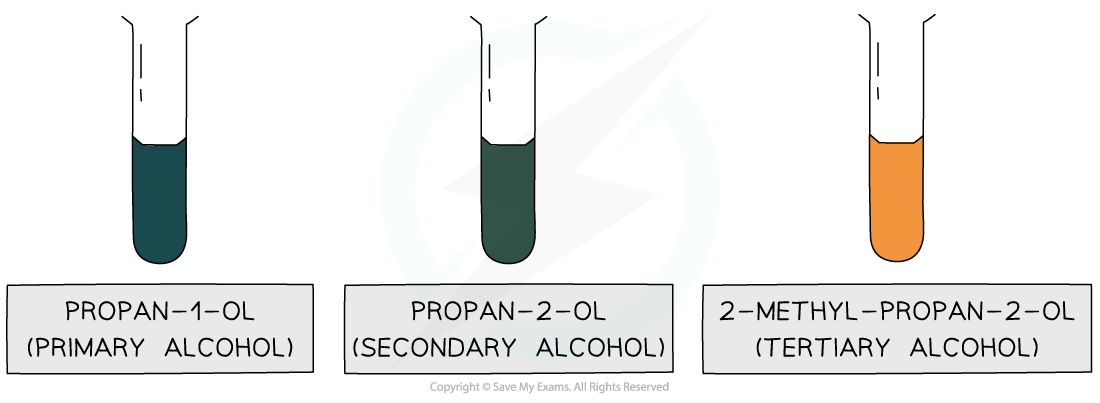Qualitative Analysis (OCR A Level Chemistry A) : Revision Note
Testing for Alkenes & Haloalkanes
Testing for an Alkene
Halogens can be used to test if a molecule is unsaturated (i.e. contains a double bond)
Br2(aq) is an orange-yellow solution, called bromine water
The unknown compound is shaken with the bromine water
If the compound is unsaturated, an addition reaction will take place and the coloured solution will decolourise

The bromine water test is the standard test for unsaturation in alkenes
Testing for a haloalkane
The haloalkane must first be warmed with sodium hydroxide in a mixture of ethanol and water
The haloalkane will undergo nucleophilic substitution releasing the halide ion into solution, which can then be tested
The released halide ion is tested for using the silver nitrate test:
Acidify the sample with dilute nitric acid (HNO3) followed by the addition of silver nitrate solution, AgNO3
The acidification is done to remove carbonate ions that might give a false positive result
If a halide is present it forms a silver halide precipitate:
Ag+ (aq) + X– (aq) → AgX (s)
Depending on the halide present, a different coloured precipitate is formed, allowing for identification of the halide ion
Silver chloride is white, silver bromide is cream and silver iodide is yellow

Each silver halide produces a precipitate of a different colour
Examiner Tips and Tricks
The acidification step in the halide ion test must be done with nitric acid rather than hydrochloric acid, as HCl contains chloride ions which would interfere with the results.
Testing for Carbonyls & Alcohols
Testing for a carbonyl
2,4-dinitrophenylhydrazine or Brady's reagent
2,4-dinitrophenylhydrazine (2,4-DNP or 2,4-DNPH) is used to test for the presence of a carbonyl group, C=O
2,4-DNP is usually dissolved in methanol and sulfuric acid
It is a pale orange solution
A few drops of the unknown sample are added to 5.0 cm3 of 2,4-DNP and it left to stand
A few drops of sulfuric acid are then added to the mixture
The formation of an orange / yellow precipitate of 2,4-dinitrophenylhydrazone confirms the presence of an aldehyde or ketone
Examiner Tips and Tricks
It is more common to use other chemical tests to more specifically check for the presence of an aldehyde or a ketone because:
Brady's reagent / 2,4-DNP only confirms the presence of a carbonyl group, it does not distinguish between an aldehyde and a ketone
Friction or sudden impacts can cause solid 2,4-DNP to explode
Testing for an Aldehyde
Tollens’ reagent
Tollens' reagent is an aqueous alkaline solution of silver nitrate in excess ammonia solution
Tollens' reagent is also called ammoniacal silver nitrate solution
When warmed with an aldehyde, the aldehyde is oxidised to a carboxylic acid and the Ag+ ions are reduced to Ag atoms
In the alkaline conditions, the carboxylic acid will become a carboxylate ion and form a salt
The Ag atoms form a silver ‘mirror’ on the inside of the tube
Ketones cannot be oxidised and therefore give a negative test when warmed with Tollens’ reagent

The Ag+ ions in Tollens’ reagent are oxidising agents, oxidising the aldehyde to a carboxylic acid and getting reduced themselves to silver atoms
Examiner Tips and Tricks
Fehling’s solution can also be used to test for an aldehyde
An aldehyde cause a change from a blue solution to a orange / brick-red prcipitate
There is no visible change for a ketone

Testing an Alcohol
Alcohols can be classified as either primary, secondary or tertiary, depending on the placement of the -OH group
Primary and secondary alcohols can both be oxidised, but tertiary alcohols cannot
To test for the alcohol functional group, add a small amount (1 cm3) of the substance to a test tube using a pipette
Then, add a small amount (1 cm3) of a suitable oxidising agent to the sample using a different pipette
The most commonly used oxidising agent for this test is acidified potassium dichromate solution (K2Cr2O7, acidified with H2SO4)
Add a stopper to the test tube and shake well
Place in a hot water bath (heated to around 60 oC) for a few minutes
If a primary or secondary alcohol are present, then the colour will change from orange to green
If a tertiary alcohol is present, then nothing will happen - the solution will remain orange

Positive test results of the oxidation of a primary, secondary and tertiary alcohol
Examiner Tips and Tricks
When heated with acidified potassium dichromate, an aldehyde will also cause a colour change from orange to green
Testing for Carboxylic Acids & Phenols
Testing for a Carboxylic Acid
Carboxylic acids in solution have a pH of around 3, so measuring the pH is a way of testing for the presence of the carboxylic acid functional group in an organic sample
The end of a glass rod could be dipped into the solution and then carefully dripped onto indicator paper
Or, a pH probe could be used, which would give you an exact pH
Since carboxylic acids are acids, they will react with a carbonate solution to produce carbon dioxide gas
1-2 cm3 of sodium carbonate (Na2CO3) or sodium hydrogen carbonate solution (NaHCO3) could be added using a pipette
If bubbles of gas are seen, this is a good indicator that the solution is a carboxylic acid
If an exam question asks you to simply distinguish between different types of organic compound, and the carboxylic acid is the only organic compound present which would react in this way with a carbonate solution, then this is enough
The gas produced could then be bubbled into limewater
If the limewater turns milky or cloudy, then this proves that the gas produced was carbon dioxide

Testing for Phenols
Bromine water can be used to test if a molecule is phenolic (i.e. contains phenol)
The unknown compound is shaken with the bromine water
If the compound contains phenol, a substitution reaction will take place and the coloured bromine water will decolourise and then a white precipitate will form

You've read 0 of your 5 free revision notes this week
Sign up now. It’s free!
Did this page help you?
